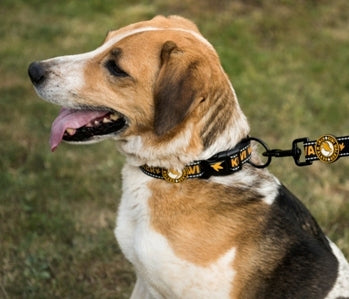
When should I change my dog’s collar?
As a dog owner you’ve probably been like me and wondered ‘when do I change and replace my dog’s collar?’ It’s obvious when they get worn or damaged but there are other times too.
Do you know what these signs are?
My Labradors have had on average a new collar once a year. More when they were younger as my 2 used to grab each others collars when out on a walk or in the garden playing! And less as they have got into their senior years, in fact by buying a good quality dog collar Pepper has had hers now for a couple of years. Their leads have been changed less frequently as it’s the collar that is important and takes the wear and tear.
I’ve shared below why you should change your dog’s collar and what to look out for in your dog’s current collar.
Has your dog grown or lost weight?
Dog’s under the age of 2 particularly, change shape and size all the time! I don’t need to tell you that if you’ve recently added a puppy to your family! To check if your puppy or young dog has grown around their neck see if you can get two fingers under the dog’s collar. If you can’t, then it is probably too small! Or you need to loosen if it’s an adjustable collar. If you can comfortably get more than two fingers under then it is probably too big and there is a risk that it may come off. If it can’t be adjusted you will need to change to a smaller size.
This applies to fully grown dogs as well as puppies. Like us, they can put on and lose weight! A regular quick check is much better rather than waiting for a collar to come off, or worse for a dog to choke with a tight collar.
Signs of wear and tear on your dog’s collar
You should always check your dog’s collar for any signs of wear and tear. Sometimes it’s not always obvious that it is damaged, especially on the inside of the collar. Fabric and nylon collars may become frayed over time and any fraying is a sure sign that the dog collar may need changing as it won’t be as strong as it was. You don’t want to leave until the collar breaks as this could be life threatening.
Be aware of the material your dog collar is made of. Leather collars are strong collars but not very water friendly. If your dog goes swimming regularly in a leather collar, you may start to see structural changes that could be weakening the leather.
Checking the fastener on the collar is also very important. If you see any signs of rusting make sure the metal work still holds, or to be safe change the collar. If the fastener gets damaged at all do change the collar immediately to prevent accidents.
Keep an eye on the thread. Whilst the rest of the collar may seem robust, the thread is what holds the whole thing together so any snap in the thread will cause a risk to the whole collar. If your dog is a chewer and manages to break the thread you are best to change the collar.
The different walking needs of a collar
The age and the type of activities you do with your dog will determine what style of collar or lead is required. Short strolls may only require a decorative collar and lead, but if you find the walks are longer and more active then you want a collar and lead that provide comfort for dog and for you!
If your dog walks off the lead a lot then take a look at a collar with a retractable grab handle built in as these are handy to hold your dog when passing any distractions without having to put them fully back onto a lead.

You may find some cheaper nylon or leather collars/leads cut into your hand, so it’s worth remembering that this could be what your dog feels around its neck. If it’s not comfortable for you it’s unlikely to be comfortable for your dog too.
At TreatYourDog we do not sell any collar that we wouldn’t use on any dog of ours or our friends, offering you the confidence that every collar is comfortable for your best friend.
Your dog’s behaviour
Your dog’s temperament and behaviour may also dictate a change, for instance if you need more control and flexibility in a walk then a collar with a grab handle could be the perfect choice. Alternatively if your dog has limited recall, a collar with extra security offers you peace of mind should it accidentally come undone.

Hopefully this has been a helpful insight into when to change your dog’s collar. If you have any questions please get in touch with us via our message button or via email on info@treatyourdog.co.uk.
If you require help in choosing the right collar or size please contact us as everyone at TreatYourDog can help. We all own dogs and have been through many collars ourselves!


